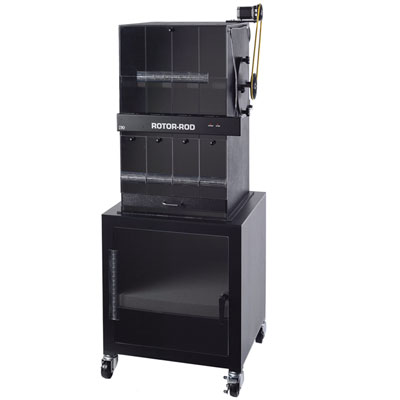Rotor Rod
Rotor Rod allows you to study motor coordination using the natural fear of falling response with reliability and accuracy. Rotor Rod allows you to study motor coordination using the natural fear of falling response with reliability and accuracy.
SDI’s ROTOR-ROD™ System exploits the natural fear of falling response to help you study motor coordination. To be sure other stimuli don’t interfere with your results, SDI’s rotarod test offers a greater range of falling heights and strategically placed photobeams to avoid false falls, unlike other systems.
Available in three sizes to accommodate mice, rats, or both, this rotarod test also gives you the option to predefine all study sessions in advance —saving time and providing maximum accuracy.

Features#
- Secured enclosure prevents animals from escaping after a safe landing
- Interchangeable rods allow you to accommodate mice and rats
- Automatically records fall latencies, distances traveled, and RPM at time of fall
- Expand your rotarod test capabilities with programmable acceleration, constant speed and deceleration-no fixed acceleration
- Adjust subject falling heights from 18-48 inches
Description#
The Rotor-Rod system measures motor function, motor learning, coordination, and equilibrium in both rats and mice. Rotor-Rod software allows the user to construct a speed control ramp of their own design. Rotor-Rod is designed with adjustable falling heights from 18-48 inches to utilize the “fear of falling” instinct as a natural motivator. Rotor-Rod is available in three configurations: a model for mice, a model for rats, and a combination model for both rats and mice. Each model features four independently timed lanes that automatically record all latencies, distance traveled and RPM at time of fall. Secured enclosures prevent the subjects from escaping after a safe landing.
SDI’s Rota Rod System highlights:#
Reliable Latency Times Ensured with a Natural Stimulus
The use of fear of falling motivation provides a natural stimulus—assuring more reliable latency times. By relying solely on fear of falling to motivate the animals to remain on the running rod, you won’t need to worry about any interfering stimuli on the rotarod apparatus. For the rotarod mice apparatus, the falling height is set to be 18” and for rats, it is adjustable up to 48”.
Run Up to Four Animals Simultaneously yet Independently
Run up to four animals at once for greater flexibility in using the SDI rota rod test. To test simultaneously, simply place one to four animals at a time in individual runs in the enclosure. When all photobeams have been broken, the rod will automatically stop rotating. You can also program a maximum test time to stop the rod, even if all animals have not fallen.
No False Falls

Seven photobeams per lane placed strategically below the running rod assure only true falls are recorded. When the animal falls from the rotor rod treadmill, the photobeams record the animal’s latency to fall and distance traveled. If the animal hangs on and moves around the rod, no fall will be recorded–unlike some other systems.
Prevent Animal Escape
Collect animals after completed tests with ease. The rota rod animal compartments are completely enclosed to prevent animals from escaping after falling from the rod.
Rotor Rod Software
Obtain the greatest level of flexibility and accuracy using the ROTOR-ROD software. Start with defining your complete study in advance by pre-assigning specific animals to specific lanes for each test session, and also by assigning a predefined Ramp Profile to each test session. The software will automatically record your session data and store it in a single study file to make sure all your data are found in one place. When you are ready, display your data right on your computer monitor or export with one click to Microsoft® Excel or to a delimited file type(TAB, CSV, etc.).
- Ensure Accurate Session Results with Saved Ramp Profiles
Construct any desired Ramp Profile for rotarod speed using acceleration, constant speed and deceleration steps in any order. Then to save time and ensure accurate duplication of scenarios, save your Ramp Profile for reuse in any rotarod test session.
- Define Your Study in Advance
Make sure you collect the most accurate data possible by defining each of your planned test sessions. You will be able to plan session parameters, set subject identifiers, assign subjects to specific test stations, and specify subject parameters such as dose level. To keep from losing any critical data, it will all be stored in a single file format.
- Automatically Run Sessions
Defining your study in advance not only saves you time by automating sessions, but eliminates run time decisions and data entry that can cause mistakes. You’ll also ensure your results are tightly coupled to your predefined subject identifiers. Simply follow the ROTOR-ROD™ software instructions to execute the test session.
- Export Directly to Microsoft® Excel (or any delimited file type)
The ROTOR-ROD™ software makes table formatted results available for direct export to Microsoft® Excel or to a delimited file type(TAB, CSV, etc.) and automatically identifies data by column headers. Since the data is exported from a single file, you won’t lose critical information and you’ll save time by removing the need to aggregate multiple single files and possibly reformat them again.
System Components Include:#
- Enclosures with 4 independently timed lanes
- Optional rotarod rat cart increases falling distance up to 48 inches
- Photobeams
- Software
- User Manual
- All cables and connectors
Specifications#
Outside Dimensions 66” (H) x 36” (W) x 24” (D) (rotarod rat); 33” (H) x 36” (W) x 24” (D) (rotarod mouse)
Lane Dimensions
4.5″ (W) per animal
Rod Diameter
1.25″ (rotarod mouse); 2.75″ (rotarod rat)
Fall Height
18” for mice, 48” for rats
Material Composition
ABS with acrylic windows
Maximum # of Stations 4 animal compartments
of Photobeams
7 per lane, 28 total
Photobeam Spacing
0.5″
Speed Range
0 to 50 RPM
Accessories#
...